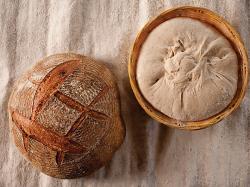Rising Action: Making Bread At Home
March 1, 2010 | 2 min to read

Of all foods, home-baked bread might be the one that appeals most equally to all
five senses. Besides the visual pleasurethe glossy russet crust, the elegant
simplicity of the form, the intricate crumbthere’s the fresh, yeasty smell of
the dough, and the supremely comforting smell of baking that fills the house.
There’s the tactile delight of kneading, and the warmth in hand of a loaf fresh
from the oven. There’s the faint ticking of bread cooling on the rack, spalling
tiny bits of crust onto the counter, the satisfying hollow-sounding thump on the
bottom that tells us it’s done, and the delightful crackle as we bite into the
crust. And there’s the flavor, of course; nothing tastes better than homemade.
Bread is the single most powerful culinary signifier of home, hearth, and
sustenance. Why do so few of us bake it?
Over the course of the last six or eight decades, we’ve outsourced many formerly
essential tasks in the name of convenience. Where food is concerned, we have
usually settled for inferior quality as a result. Now we’re often afraid of
these simple culinary projects, which hundreds of generations before us executed
daily without the benefit of much technology besides fire. And that’s the
important thing to remember: Though science has brought many astonishing
improvements to our lives, better bread is not among them.
Yeast gone wild
Many of our staple foods would not be possible without the collaboration of
microorganisms. Fermented pickles, alcohol, vinegar, cheese, and bread would be
impossible without the help of millions of tiny creatures in every batch. The
key with all of these products is to set up conditions so that the beasts can
thrive, and then let them do all of the heavy lifting. (In the case of bread,
the lifting is literal.) The creation and care of a wild yeast starter is
incredibly easy, and the resulting bread is as good as it gets: tangy and
complex, with lots of character. If you’re a novice, by all means begin with
commercial yeast to get acquainted with the basic process. But if you have some
experience, a live starter will make the best bread you’ve ever eaten.
Photo Caption: Bread from the oven of Peter Alexander, author of the upcoming
book 52 Loaves.
Photo Credit: Jennifer May
To read the rest of this story please go to:
Chronogram.com
